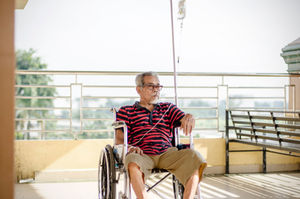Endobronchial Metastatic Renal Cell Cancer Resection and Stent for Palliation
- Mark Esterle, MD

- Mar 5, 2020
- 5 min read
Often my Blog articles are about patient education. Something that one of my patients asked about at a recent visit or something I read about that inspires. This is a little different in that it is a patient story. A brief but important interaction in which I had the pleasure of being involved.
Sometimes the goal of treatment is cure and sometimes it is simply comfort. As a critical care physician, I often have conversations with patients and family members about when is enough, enough. At what point do we cross the threshold from doing things for people to just doing things to people. The decision is always on an individual case-by-case basis. Sometimes patients surprise me.
Patients always ask, “How much time do I have left doc?” More often than that however it is family members asking the questions. I have stopped giving estimations in relation to how much time a patient may have. I have been wrong so many times. Sometimes you expect patients to progress rapidly, yet they defy all the odds. Sometimes, no matter what you do, you cannot slow down the progression of disease. We are all going to die one day, and we cannot do anything about it. We can, however, help with suffering and controlling symptoms.
My discussion with patients and families in relation to end-of-life care is now more vague. Instead of giving specifics I talk in relation to… days to weeks, weeks to months, months to years depending on the patient’s condition and prognosis. Often the treatment is medication for pain, secretion control and anxiety for the most part. In some cases, however, there are rare times in which an invasive approach is still appropriate for palliative reasons, giving patient’s comfort. This is often the case with interventional pulmonary procedures.
A most recent case comes to mind. I will not share his name, although I do not think that he would mind, to protect his privacy. A very pleasant 69-year-old male with metastatic renal cell carcinoma who follows with one of my partners. He was recently admitted to the hospital with increased cough and shortness of breath. He was noted to have positive respiratory viral panel for Coronavirus. Incidentally, this is not the Coronavirus you are hearing a lot of in the media and simply the standard Coronavirus that we see every year in multiple patients that causes the common cold. In him however this caused significant symptoms as he was essentially immunocompromise due to his malignancy.
He has had complications along his course including infections, difficulties with chemotherapy regimen, deep vein thromboses and most recently near complete collapse of his right lung due to obstructing tumor in the right main airway of his right lung. This obstructing mass prevented air getting to his right lower and right middle lobe of the right lung and made it difficult to clear secretions. Because he could not clear the secretions well, he had persistent and recurrent infection with post obstructive pneumonia symptoms. His symptoms of shortness of breath and cough significantly worsened. In some cases, we would treat this with pain medication and anxiety medicines predominantly and focus on comfort. In his case, we are still focusing on comfort, however, took a much more aggressive approach. He has kept a positive attitude through it all.
First, we had to hold his blood thinner, Coumadin, he was on for atrial fibrillation and history of DVT until his coagulation levels were in a safe range to consider attempting to remove the airway tumor. The hope was that we could open things up enough so that he could breathe using the lower part of his right lung and clear secretions more easily. I took him to the operating room and using laser treatment and cryo-probe treatment for tumor debulking and hemostasis control I was able to remove enough of the tumor to core out a tunnel through the tumor opening the lower lung on the right. Sometimes when I do this, I have to use what is called a rigid bronchoscope which allows me to use much larger tools than I can use through the standard flexible scopes we more frequently use but it is kind of like trying to do the surgery through the barrel of a gun. The tools can be larger, but mobility control is significantly reduced. After successfully, painstakingly, piecemealing out the obstructing mass I was able to dilate the right main airway and enlarge the space for improved aeration and clearance of secretions. He had significant relief of his symptoms of shortness of breath and cough immediately. His wife sent me a text later in the evening stating that he was feeling so much better. She said that they even went out to dinner as he was feeling better than he had had for months; something they had not been able to do for a while. This feeling lasted for about 3 days until he started to get short of breath again as the airway was re-collapsing.
I must say, I expected this to happen. My first goal was to determine if it was even possible to open the lower lung. Next step is to try to keep it open. Based on how well I was able to dilate the airway with the balloon dilators during the initial procedure and measurements based off his recent CT scans of his chest, I was able to order a specially designed stent for him that I would later place in the airway to prop open the collapsing right lung. The stent is made of metal and plastic that is flexible and designed to be compressed into a very tightly packaged device. It is a little bit thicker in diameter than a straw you would use to stir your coffee. Using fluoroscopy for help with visualization I was able to successfully deploy the stent in position, propping open the right lung and pushing the tumor out of the way. This way, the airway can no longer collapse, and his number of symptom free days will be increased.
Not everyone requires or would even benefit from this type of aggressive treatment with stage IV cancer, but it is a very satisfying feeling of accomplishment when I am able to make a difference for patients like this. The number of cases that require this level of care is not robust, so, as you would expect, there are not many doctors that are trained in these procedures and in many cities across the nation there are none. These cases tend to be highly complex and certainly tend to take a significant amount of time. The time is much longer than standard bronchoscopy an average pulmonologist would do, and reimbursement is not really any better than standard bronchoscopy would be so the incentive for more doctors to provide services like this is low. That being said, the satisfaction that I get from making this type of difference for patients is priceless and well worth the extra effort.
In my patient’s case from today, I am very hopeful that he will have many symptom-free days and be able to do things he wants to do, like go out to dinner with his wife more often. To be able to just feel normal and go out on a date with his wife, forgetting that he is a stage IV cancer patient for the evening. Again, what I think is most impressive to me is his positive attitude that he has had throughout this process and in talking with his oncologist this has been unwavering.
Pictures listed below are graphic showing tumor in airway prior to debridement, post and airway after stent placement. Graphic images may not be appropriate for all ages.














Thanks for sharing this, it was very informative. As a patient I appreciate your attention and concern to comfort and quality of life. Keep up the great work!